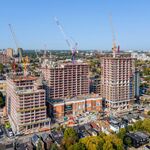Metrolinx: Toronto needs to sign on dotted line for new light-rail plan
Published On Thu Feb 16 2012
Tess Kalinowski
Transportation Reporter
Toronto’s return to an above-ground light rail plan will need to clear at least one, and possibly two, more hurdles at city council before Metrolinx considers the matter settled.
First council has to approve a plan for Sheppard East, where Mayor Rob Ford wants to build a subway — so far unfunded — but many transit experts say a road-level LRT makes more sense. A panel of outside experts will make its recommendations to council by March 21.
But the $8.4 billion provincially funded transit plan, endorsed at a special meeting of council last week, won’t be final until the city signs a master agreement confirming all the details, said Metrolinx chair Rob Prichard. That contract could go through council or be delegated to city staff.
Whatever the mechanics of entering that agreement, “That will be the moment when we’re bound together by contract,” he told reporters following the public session of the Metrolinx board on Thursday.
The Sheppard panel meets Friday behind closed doors. Led by city manager Joe Pennachetti, it will include advice and support from Metrolinx, but no one from the province will sit on the panel.
The Toronto Board of Trade has also refused to sit among the experts that include Ford’s subway point man Gordon Chong, U of T Cities Centre director Eric Miller and former mayor David Crombie.
“We believe that Metrolinx should be the body to lead those kind of discussions — on what needs to be built, where it needs to be built and when it needs to be built. The province should allow them to do that, to basically move forward on the mandate they were given, which we don’t believe they’re being given from the province right now,” said Carol Wilding, president of the Toronto Board of Trade.
Metrolinx needs to listen to municipalities and balance their needs within the region, while de-politicizing the process, she said.
But the politics of transit were clearly worrying some members of the Metrolinx board Thursday.
Doug Turnbull, deputy chairman of TD Securities, worried aloud whether the province might pull its funding in light of the dire financial warnings in Don Drummond’s Wednesday report.
“My concern is we have a mayor who doesn’t want to take yes for an answer,” he said, although Prichard said the province’s financial commitment remains firm.
But in a farewell speech urging Metrolinx to take the politics out of transit planning, outgoing board member Paul Bedford warned that doing nothing “is the worst consequence.”
Bedford, one of the few founding members remaining on the Metrolinx board, learned last month that his term wasn’t being renewed. Toronto’s former head planner said, “It reinforced my belief that planning is political.”
His parting message to Metrolinx was that it needs to be bold. He urged the board to immediately begin campaigning for the regional taxes and tolls needed to raise $3 billion a year toward the Metrolinx transit expansion plan.
Bedford acknowledged that those revenue tools, including a regional sales tax, road tolls and more gasoline tax, are “politically hot as hell.”
But, he said, “The question should be, ‘Do you want subways and are you prepared to pay from this revenue menu to get them?’”
“This board is not here to give political advice,” he said. “It is not a branch of the Ontario Ministry of Transportation.”





